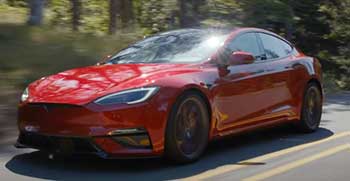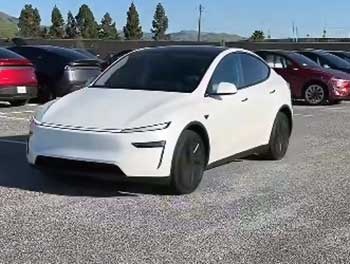I’ve always been fascinated by Tesla’s electric vehicles, and after spending time with both the Model X and Model Y, I’m excited to share my journey. T
his article compares these two SUVs from a real user’s perspective, exploring their strengths, weaknesses, and what it’s like to live with them.
Whether you’re a family driver, a tech enthusiast, or just curious about Tesla’s lineup, I’ll break down the key features, pros, cons, and maintenance tips to help you decide which model fits your lifestyle.
Let’s explore what makes these vehicles unique and which might be your perfect match.
Comparison Table: Tesla Model X Vs. Tesla Model Y
| Feature | Tesla Model X | Tesla Model Y |
|---|---|---|
| Price (Starting) | $91,630 | $44,990 |
| Range (EPA) | 348 miles (Long Range) | 330 miles (Long Range) |
| Seating Capacity | Up to 7 | Up to 7 (optional) |
| Cargo Space | 91 cu. ft. | 76.2 cu. ft. |
| 0-60 mph | 3.8 sec (Long Range), 2.5 sec (Plaid) | 4.8 sec (Long Range), 3.5 sec (Performance) |
| Drive Type | All-Wheel Drive | Rear-Wheel or All-Wheel Drive |
| Infotainment Screen | 17-inch tilting touchscreen | 15-inch touchscreen |
| Unique Features | Falcon Wing doors, air suspension | Compact design, optional tow hitch |
| Towing Capacity | 5,000 lbs | 3,500 lbs (with tow package) |
| Reliability (J.D. Power) | 71/100 | 69/100 |
My Experience With Tesla Model X

Driving the Tesla Model X feels like stepping into a spaceship.
The first thing that struck me was the Falcon Wing doors—they’re not just a gimmick but a game-changer in tight parking spaces, making it easy to load kids or cargo.
The 17-inch tilting touchscreen is a tech lover’s dream, controlling everything from climate to navigation with a sleek interface.
I took the Long Range model on a road trip, and its 348-mile range let me cruise without constant charging worries. The air suspension smoothed out bumpy roads, and the Plaid version’s 2.5-second 0-60 mph sprint was thrilling, though I rarely needed that power.
The spacious interior, with room for seven, was perfect for family outings, and the 91 cubic feet of cargo space swallowed gear effortlessly. However, the premium price tag—starting at $91,630—made me question its value compared to other EVs.
Maintenance was straightforward, thanks to over-the-air updates, but the complex doors and suspension occasionally needed professional attention. I loved the luxury and tech, but the Model X felt like overkill for daily commutes. It’s a statement vehicle, ideal for those who want the ultimate Tesla experience and don’t mind the cost.
Pros Of Tesla Model X
- Spacious Interior: The Model X offers up to 91 cubic feet of cargo space and seating for seven, making it ideal for families or those needing extra room for gear.
- Falcon Wing Doors: These upward-opening doors are visually stunning and practical, providing easy access in tight spaces, especially for rear passengers.
- Impressive Range: With up to 348 miles in the Long Range model, it’s perfect for long trips without frequent charging stops.
- Blazing Performance: The Plaid model’s 1,020 horsepower and 2.5-second 0-60 mph time make it one of the fastest SUVs on the market.
- Advanced Tech: The 17-inch tilting touchscreen, 22-speaker audio system, and adaptive air suspension elevate the driving experience to a premium level.
- Towing Capability: With a 5,000-pound towing capacity, it’s well-suited for hauling trailers or small boats, surpassing many electric SUVs.
- Safety Features: A five-star Euro NCAP rating and advanced driver-assistance systems like Autopilot ensure top-tier safety.
The Model X’s blend of luxury and utility is hard to beat. Those doors always turned heads, and the interior space made family trips a breeze. The tech kept me engaged, but the performance felt like a bonus I rarely tapped into fully.
Read more: My Thoughts on Honda Odyssey Vs. Subaru Ascent
Cons Of Tesla Model X
- High Price: Starting at $91,630, it’s significantly more expensive than the Model Y, which offers similar features for less.
- Reliability Concerns: J.D. Power rates it at 71/100, slightly above average, but issues with Falcon Wing doors and air suspension can arise.
- Complex Maintenance: The unique doors and suspension require specialized repairs, which can be costly and time-consuming.
- Large Footprint: At 199.1 inches long, it’s harder to maneuver in urban settings or tight garages compared to the Model Y.
- Battery Degradation: While minimal, long-term battery wear is a concern, especially for high-mileage drivers, requiring careful charging habits.
- Overkill for Some: The premium features and performance may be excessive for those who just need a practical daily driver.
- Limited Incentives: Unlike the Model Y, the Model X often doesn’t qualify for federal EV tax credits, increasing the effective cost.
The price stung, and I worried about repair costs for those fancy doors. It’s a fantastic vehicle, but it’s not for everyone—especially if you’re budget-conscious or live in a crowded city.
Maintenance Tips For Tesla Model X
- Monitor Battery Health: Charge to 80-90% daily and avoid letting the battery drop below 20% to extend its lifespan.
- Regular Software Updates: Accept Tesla’s over-the-air updates promptly to keep the vehicle’s systems optimized and secure.
- Check Falcon Wing Doors: Inspect door sensors and hinges monthly to prevent malfunctions; clean them to avoid debris buildup.
- Tire Maintenance: Rotate tires every 6,000 miles and check pressure monthly, as the heavy Model X can wear tires quickly.
- Clean Air Suspension: Keep the air suspension system free of dirt and grime, especially in winter, to maintain smooth operation.
- Use Tesla Service Centers: For complex issues like door or suspension repairs, rely on Tesla’s certified technicians to avoid improper fixes.
- Wiper and Filter Care: Replace cabin air filters annually and check wiper blades regularly to ensure visibility in all conditions.
I found that staying proactive with software updates and battery care kept the Model X running smoothly. The doors and suspension need extra attention, but Tesla’s service network made it manageable.
My Experience With Tesla Model Y
The Tesla Model Y feels like the practical sibling of the Model X, blending efficiency with versatility. I drove the Long Range All-Wheel Drive model, priced at $47,990, and its 330-mile range was plenty for my daily commutes and weekend getaways.
The 15-inch touchscreen was intuitive, though smaller than the Model X’s, and the minimalist interior felt modern but not as luxurious. Parking was a breeze thanks to its compact 187-inch length, and the 76.2 cubic feet of cargo space handled groceries and sports equipment with ease.
The optional seven-seat configuration ($2,000 extra) was snug but worked for short trips with kids. The Model Y’s acceleration (4.8 seconds 0-60 mph) was peppy, though not as jaw-dropping as the Model X Plaid.
I appreciated the affordability and potential federal tax credit of up to $7,500, which made it feel like a smarter buy. However, the standard suspension wasn’t as plush, and the cabin was noisier at highway speeds. For urban drivers or small families, the Model Y is a no-brainer, offering most of Tesla’s tech at a lower price.
Pros Of Tesla Model Y

- Affordable Price: Starting at $44,990, it’s nearly half the cost of the Model X, with potential EV tax credits lowering the price further.
- Compact Design: At 187 inches long, it’s easier to park and navigate in cities than the bulkier Model X.
- Solid Range: The Long Range model’s 330 miles is close to the Model X, making it great for daily and long-distance driving.
- Versatile Seating: The optional seven-seat configuration adds flexibility for families, though the third row is best for kids.
- Towing Option: With a $1,000 tow hitch, it can tow up to 3,500 pounds, suitable for light trailers or bikes.
- Advanced Tech: Features like Autopilot, a 15-inch touchscreen, and over-the-air updates keep it cutting-edge.
- Reliability Edge: A J.D. Power score of 69/100 suggests decent reliability, with fewer complex components than the Model X.
The Model Y’s price and size made it my go-to for city driving. It’s not as flashy, but it gets the job done with Tesla’s signature tech and efficiency.
Cons Of Tesla Model Y
- Less Premium Feel: The interior materials and standard suspension don’t match the Model X’s luxury or comfort.
- Snug Third Row: The optional seven-seat configuration is cramped, limiting its practicality for larger groups.
- Smaller Cargo Space: With 76.2 cubic feet, it’s less spacious than the Model X, which could be an issue for heavy packers.
- Noisy Cabin: At highway speeds, road and wind noise are more noticeable compared to the quieter Model X.
- Limited Towing: The 3,500-pound towing capacity is lower than the Model X, restricting heavier loads.
- Basic Features: Lacks premium touches like ventilated seats or a tilting screen, which the Model X includes standard.
- Range Drop in Cold: In winter, the range can dip significantly (e.g., 320 km at -10°C), requiring more frequent charging.
The Model Y’s simplicity is a double-edged sword—affordable but less refined. I missed the Model X’s luxury, but the Y’s practicality won me over for daily use.
Also read: My Thoughts on Ford Edge Vs. Hyundai Tucson
Maintenance Tips For Tesla Model Y
- Optimize Battery Charging: Charge to 80% for daily use and avoid deep discharges to maintain battery health over time.
- Stay Updated: Install Tesla’s software updates as soon as they’re available to enhance performance and fix bugs.
- Tire Care: Check tire pressure monthly and rotate every 6,000 miles to ensure even wear, especially with frequent city driving.
- Clean Sensors: Wipe down cameras and sensors regularly to keep Autopilot and safety features functioning properly.
- Inspect Brakes: Check brake pads every 12,000 miles, as regenerative braking reduces wear but doesn’t eliminate it.
- Cabin Filter Replacement: Swap out the cabin air filter yearly to maintain air quality and HVAC efficiency.
- Use Tesla Service: For any electrical or software issues, stick to Tesla service centers for expert diagnostics and repairs.
Maintaining the Model Y was a breeze, with software updates handling most issues remotely. Regular tire and sensor checks kept it in top shape without much hassle.
Frequently Asked Questions (FAQ)
It depends on your needs. The Model X is better for those seeking luxury, more space, and top performance, while the Model Y suits budget-conscious buyers or urban drivers needing a compact, efficient SUV.
Tesla hasn’t stopped producing the Model X. It remains in their lineup as a premium SUV, though some speculate future updates may come due to competition and the Model Y’s popularity.
The Model Y offers the best value, starting at $44,990 with potential tax credits, delivering most of Tesla’s tech and a solid 330-mile range at a lower cost than the Model X.
The Model X is bigger, measuring 199.1 inches long and 78.7 inches wide, compared to the Model Y’s 187 inches long and 75.6 inches wide, offering more interior and cargo space.
Conclusion: For Tesla Model X And Model Y
Choosing between the Tesla Model X and Model Y comes down to what you value most. If you crave luxury, space, and jaw-dropping performance, the Model X delivers with its Falcon Wing doors and plush features, but you’ll pay a premium.
If you want affordability, practicality, and efficiency, the Model Y is your match, offering most of Tesla’s tech at a lower price. Both SUVs impressed me, but your lifestyle—whether it’s family trips or city commutes—will decide the winner. Test drive them, weigh your budget, and pick the one that sparks joy for you.

